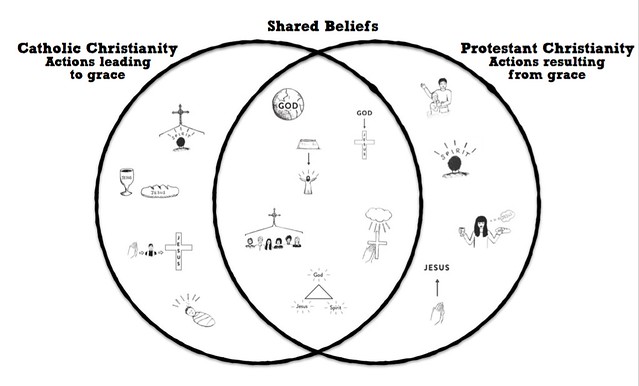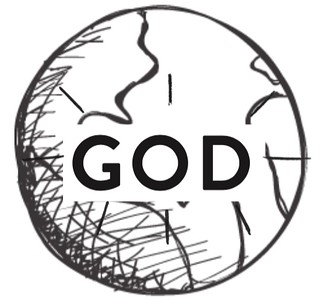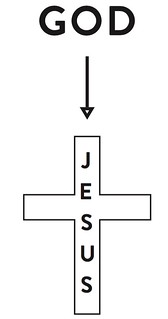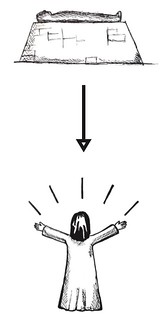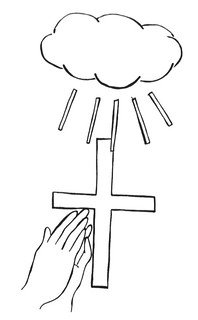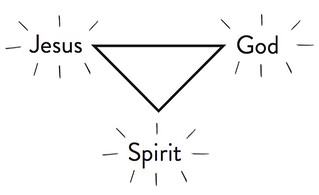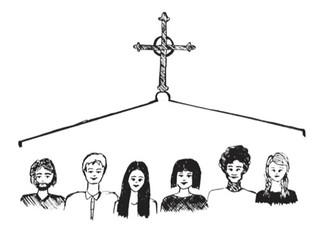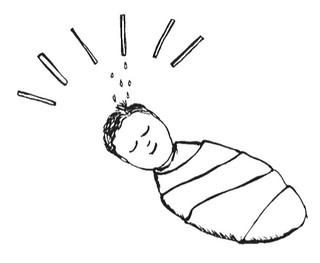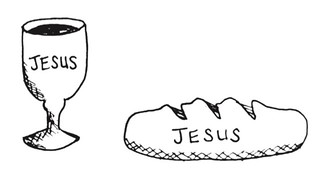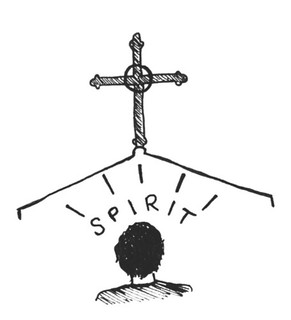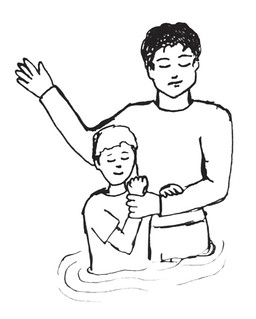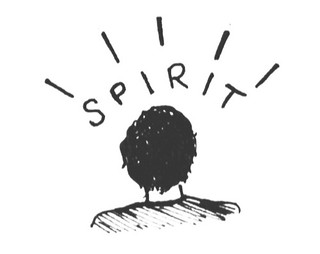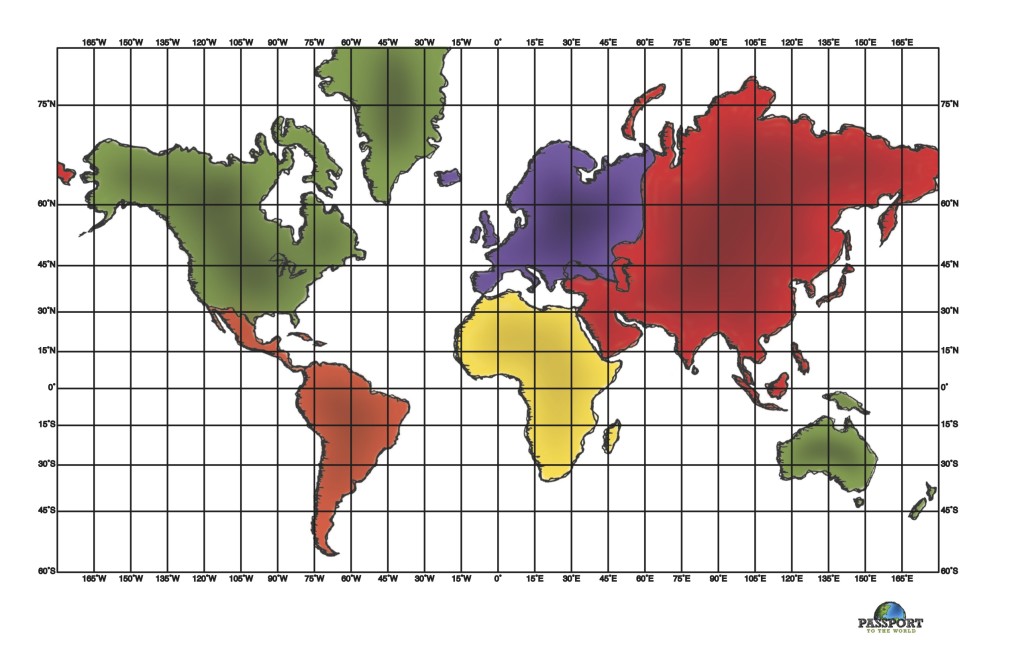Roman Catholicism is the primary religion in Latin America. Seven out of every 10 people in Latin America claims to be Catholic and this makes up one third of all Catholics throughout the world. Catholicism was introduced to Latin America over 500 years ago when Christopher Columbus and the explorers arrived from Spain. The Spanish were Roman Catholic so they built Catholic churches and missions throughout Latin America.
Roman Catholicism is also called Catholic Christianity. It shares beliefs from the Bible with Protestant Christianity, but differs in some interpretations of scripture and the addition of certain traditions and practices.
Note to teacher:
Before class: print resource Statement Cards, (two-sided on card stock) and cut into separate cards.
During class: Pass out statement cards to students. As you teach through each section of the lesson, instruct students to place corresponding cards on the diagram in the correct location.
Similarities and Differences Activity
Materials:
- Statement cards
- Tape
- White board and Expo marker
Procedure:
Draw two large circles that overlap to form a Venn diagram on the board. One circle will be labeled “Catholic Christianity” and the other circle will be labeled “Protestant Christianity”. The area of overlap will be labeled “Shared Belief”.
Pass out statement cards to students. Each card will have a picture on the front and the category and statement on the back. Students will take turns placing cards on the board in the correct area. As each card is presented, discuss how the card meets the criteria for the big picture ideas:
- Shared Belief
- Actions leading to grace
- Actions resulting from grace
Shared Beliefs: The shared beliefs for both groups are based on documents— the Nicene Creed (325 A.D.) and the Apostles’ Creed (formally introduced in 390 A.D.)—compiled to establish Biblical truths that were shared by all Christians.
The following statement cards should be placed in the Shared Beliefs section of the Venn Diagram.
God is our Father and Creator:
God sent His son, Jesus, to die for our sins:
Jesus rose from the dead and broke the curse of sin and death:
Jesus offers forgiveness and eternal life to those who turn to Him:
The Holy Spirit is part of the Trinity with God and Jesus:
The church is made up of the faithful followers of Christ:
Catholic Christianity:
Add the words “Actions leading to grace” under this category. Explain to students that Catholic Christians participate in sacraments, which are religious ceremonies or acts that are an outward expression of an inward divine grace. In the Catholic church, these sacraments are seen as actions that open the door for God’s saving grace…. or actions leading to grace.
The following statement cards should be placed in the Catholic Christianity section of the Venn Diagram:
Confession to an earthly priest is a sacrament that leads to forgiveness of personal sin and peace with the Father, Son, and Holy Spirit.
Baptism is a sacrament that provides the gateway for salvation as it removes original sin and is a picture of a spiritual cleansing.
Communion is a sacrament in which bread and wine become spiritual food that feed the soul and provide a spiritual union between the soul and Christ.
Commitment: Confirmation is a sacrament and a process in which a person makes a commitment to Christ and the local church and is sealed with the Holy Spirit.
Protestant Christianity:
Add the words “Actions resulting from grace” under this category. The Protestant church shares several practices with the Catholic church, such as communion and baptism. The difference lies in the fact that the Protestant church does not see the act as a way to work out salvation, but rather as a symbol of an inward salvation that has already occurred. As a result, these practices are seen as actions resulting from grace.
The following statement cards should be placed in the Protestant Christianity section of the Venn Diagram:
Confession: Personal sins are confessed directly to Jesus, our Great High Priest, and forgiven by Him through prayer so that a right relationship with Him can be restored.
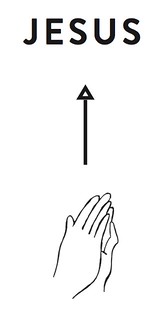 Baptism does not remove sin, but is experienced as a result of salvation to show others the believer’s identification with Christ’s death and resurrection.
Baptism does not remove sin, but is experienced as a result of salvation to show others the believer’s identification with Christ’s death and resurrection.
Communion is a symbol of the body and blood of Christ taken as a result of salvation and is a reminder of how His death on the cross led to reconciliation with God.
Commitment to Christ is called salvation and is the point at which a person receives the Holy Spirit’s presence and follows with a desire to serve and grow as a Christian with other believers through a local church.
Discuss and review the above similarities and differences to improve clarity. If time permits, remove cards and have students place cards on correct location on Venn Diagram a second time based on their memory of the pictures’ meaning. Students may look at back of card to cue memory as needed.
It is important to focus on the shared beliefs of Christians while also seeking God’s Word for clarity about the beliefs that differ. The Book of James in the New Testament is evidence that the topic of “faith versus works (or actions)” was a source of discussion and disagreement in the early Church. James tells us that both should be evident in a person who follows Christ:
But someone will say, “You have faith and I have works.”
Show me your faith apart from your works,
and I will show you my faith by my works. James 2:18
James is reminding them that faith and works are intertwined. A Christian’s faith should lead to works that show others their faith. If a person takes part in a sacrament, but does not have faith, he is trying to gain salvation by his own works rather than through the sacrifice of Christ.
For by grace you have been saved through faith. And this is not your own doing;
it is a gift of God, not a result of works, so that no one may boast. Ephesians 2:8-9
If a person has faith, that person should desire to participate in baptism, communion, and committed ministry with the church body. A faith without these is dead. As Christians, we serve Christ, the son of the Living God, so our faith in Him must also be alive. Let’s live out our faith so that others can find life in Him!


